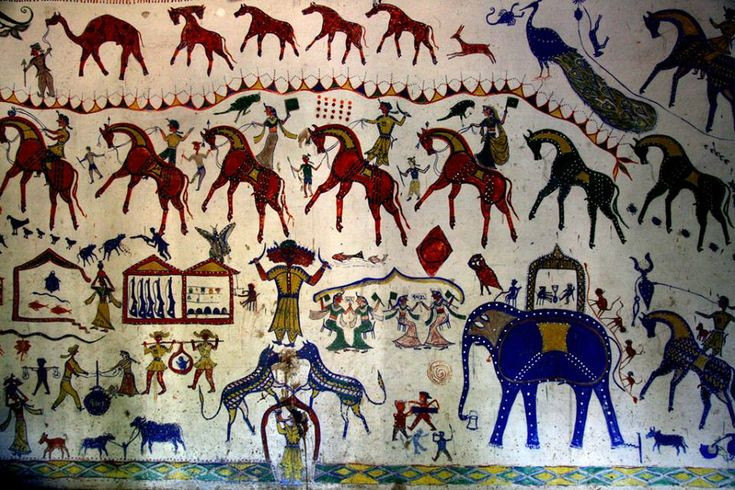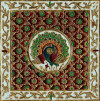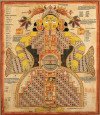Gujarat is one of the richest states in our country. Apart from being famous for its temples, wildlife sanctuaries, ports, and the Rann of Kutch, Gujarat is also famous for its diverse cultural heritage. In this article, we are going to take a peek into their culture and re-discover one of the most fascinating art forms known as Pithora Paintings.
History and Origin of Pithora Paintings
In the land of temples and numerous deities, Pithora (Baba Pithora) is the deity who was worshipped for marriages and functions, similar to the Greek Goddess Hera. The tribes such as the Rathwas and the Bhilalas from a village in central Gujarat worshipped Baba Pithora. The paintings were made on their walls or on the walls of caves to worship Baba Pithora.
Pithora paintings were made to seek blessings from the deity, or thank/ask them for a boon. Hence, it is more like a ritual than an art form. Whenever someone has a desire or problem, they narrate it to their head priest (Bhadvo). The priest after listening to their difficulties comes up with a solution and instructs the person to perform the ritual and the painting. These paintings are made across three walls, the front or central wall and two adjacent walls, such that it is visible to whoever is entering or leaving the house. Baba Pithora was considered to be very auspicious and so they tried to make him a part of every aspect of their lives.
Apart from the rituals, there were certain rules to be followed while painting. Back in ancient India, menstruating women were known to be impure, and so they were not allowed to be involved with painting.
Materials Used and Process of Pithora
This ritual was a three-day-long process. Young unmarried girls were asked to smear the walls with dung, water, and chalk. This process is known as “Lipai”. Then the Bhavdo instructs one of the males with the details. The males who painted them are called “Lakhindra”. In these paintings, we can see a vivid range of colors like green, red, orange, blue, and pink. They use branches of Tendu and Palash trees to make a brush for the art. The paint was made by mixing various pigments with milk and liquor prepared with extracts from Mahuda Tree. We can usually identify these paintings by their signature mascots like horses, sun, moon, birds, animals, trees, etc. The paintings don’t illustrate Baba Pithora but they exhibit various lores surrounding him.
Themes of Pithora Painting
The most important theme of this painting is the marriage of the deity Pithoro with Pithori. Various stories and lores related to the events leading up to their marriage were drawn in the paintings. These paintings were considered to be very sacred. Therefore, people often celebrate completing a painting with dance, music, and sometimes animal sacrifices.
Another interesting theme of these paintings is Maps. The horses in the paintings stand for the hills surrounding the areas where the tribal people of Rathwas reside. The rectangular borders show the area of their territory. The wavy lines in the paintings are the river Narmada passing through their lands. The trees, wildlife, farms, etc. were positioned concerning their geographical locations. Hence, in the 11th century, these paintings were used to describe maps by traders to keep their routes safe and secret from common people.
Other representations include daily activities such as farming, hunting, plowing and festivals, and other social events.
Renowned Artists
Women were once forbidden from learning this art because they were considered impure by society, and today women are saving this form of art from extinction. This is another example of the evolution of mankind.
From a small village in Madhya Pradesh, Bhuri Bai is the first person to transfer these mesmerizing paintings from the walls to a canvas. She overcame all the barriers of this patriarchal society and received the Padma Shri Award in 2021. Her paintings are exhibited in various art galleries and museums in Europe, Australia, and the US. She is also the co-author of the book Dotted Lines (by Debjani Mukherjee), which is her biography expressed through Pithora Paintings.
Her journey did not end after achieving success and fame in the field of art. Bhuri Bai let her daughter, Shanta Bhuria, follow in her footsteps in the world of art. This 25-year-old girl has about 25 of her paintings displayed at the Madhya Pradesh State Tribal Museum. Shanta’s paintings describe modern-day events related to the pandemic journeys in a bus and war. Some other works of hers include traditional aspects like animals, nature, and women performing daily chores.
Current Scenario
Just like humans have evolved and adapted to the changes around them, we can see how the Pithora paintings have acquired a position in this modern world. In original paintings, we could see the deities or people in traditional attire like dhotis and riding horses. Nowadays the deities have a more modern outlook as if they had a makeover. So, we find them in trousers and riding bikes and trucks instead of horses. The world around us is changing and why should our beloved deities lag in the fashion department?
Online platforms, such as ARTSofINDIA.in, are constantly working to uphold such arts and recognize and acknowledge the artists across the country.
These modified paintings can be found on many public buildings like healthcare centers and schools in Chhota Udepur. As mentioned in an article by TOI, these changes are being requested by clients and so, the original painters or Lakhindras are encouraged to make these changes.
Picture Source: Pinterest



